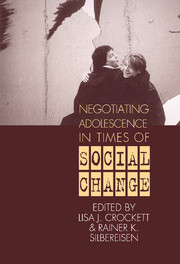Book contents
- Frontmatter
- Contents
- Contributors
- Preface
- 1 Social Change and Adolescent Development: Issues and Challenges
- Part I Models of Social Change Effects
- Part II Social Change and Adolescent Transitions
- 5 The Global Spread of Adolescent Culture
- 6 Social Change and the Sequencing of Developmental Transitions
- 7 German Unification and Adolescents' Developmental Timetables: Continuities and Discontinuities
- 8 Adolescents in Changing Social Structures: Bounded Agency in Life Course Perspective
- Part III Social Change and Adolescents' Social Contexts
- Part IV Implications of Social Change for Adolescent Health and Well-Being
- Part V Interventions: Promoting Healthy Development in Times of Social Change
- Endnotes
- Index
7 - German Unification and Adolescents' Developmental Timetables: Continuities and Discontinuities
Published online by Cambridge University Press: 26 January 2010
- Frontmatter
- Contents
- Contributors
- Preface
- 1 Social Change and Adolescent Development: Issues and Challenges
- Part I Models of Social Change Effects
- Part II Social Change and Adolescent Transitions
- 5 The Global Spread of Adolescent Culture
- 6 Social Change and the Sequencing of Developmental Transitions
- 7 German Unification and Adolescents' Developmental Timetables: Continuities and Discontinuities
- 8 Adolescents in Changing Social Structures: Bounded Agency in Life Course Perspective
- Part III Social Change and Adolescents' Social Contexts
- Part IV Implications of Social Change for Adolescent Health and Well-Being
- Part V Interventions: Promoting Healthy Development in Times of Social Change
- Endnotes
- Index
Summary
The unification of Germany in 1989 represents a particular case of rapid rather than gradual social change. According to the dominant view of this event and its aftermath, the unification process, at least in the beginning, was primarily characterized as a replacement of East German social institutions by their West German equivalents (Zapf, 1996). An example is the dissolution of the Eastern system of comprehensive schools in favor of the three-track Western system, which distinguishes tracks leading to professional careers as opposed to academic careers from early on. In this sense, practically all social institutions dealing with education, labor, internal security, and many more concerns underwent rapid and encompassing changes (Kornadt, 1996).
Many of the postunification problems, such as the profound difference in what performances people in the two regions of the country expect from state authorities with regard to public welfare, seem to be rooted in the failure of the change of peoples' minds and attitudes to progress at the same pace as the institutional changes (Zapf, 1996). Put in other words, the situation, even several years after unification, still reflects what Elder described as inherent to social change in peoples' lives: Individuals experience a more or less pronounced mismatch between new challenges and established resources from the past. This mismatch is likely to be perceived as a partial loosening of personal control. Whether this focuses attention, with the result of more forceful attempts at regaining control, or whether it results in desperation, depends on many factors, including basic features of individuals' personality structures (Elder, Caspi, & Burton, 1988).
- Type
- Chapter
- Information
- Negotiating Adolescence in Times of Social Change , pp. 104 - 122Publisher: Cambridge University PressPrint publication year: 1999
- 2
- Cited by



